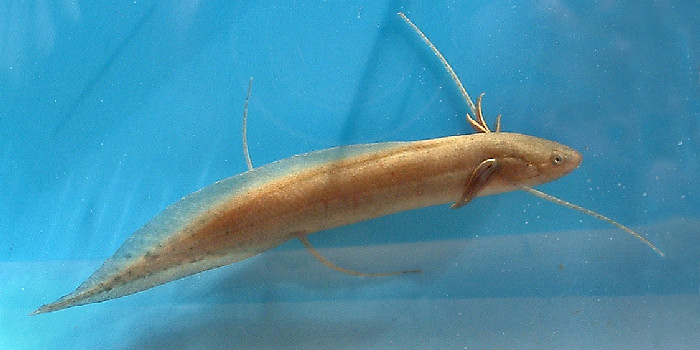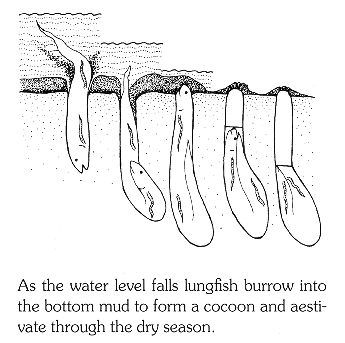

Above: A lungfish, Protopterus annectens brieni, has now been documented to occur in Lake Malawi. Lungfishes were accidentally introduced into the dambo (swamp) of the Mpatsanjoka River, along the Senga Bay—Salima road, Malawi (Tweddle, 1989). A data record at the South African Institute for Aquatic Biodiversity documents this swamp occurrence (as the nominate subspecies, P. annectens annectens). Dr. Jos Snoeks of the African Museum in Tervuren (Belgium) takes up the story from there:"[The lungfish] has never been reported from the lake itself, but was found in quite large numbers in the river system close to the point of introduction. However, early in 1999 I observed it in the lake in front of the project after major floods in the Salima/Senga Bay area. In addition, the species was recently found in marshy areas in the southeastern part of the lake, near Monkey Bay (Weyl, pers. comm.)." — Snoeks (2004b: 20)Thus, Protopterus annectens brieni (as the subspecies is now identified) must be added to the fauna known to occur in Lake Malawi.

Above: a lungfish larva (Protopterus annectens brieni) from the Mpatsanjoka dambo (swamp) on the main
Salima-Senga Bay (Malawi) road. Photo taken in 2004, © by Dr. George Turner
Elsewhere, P. a. brieni is distributed on the Mozambique coastal plain, from the lower Zambezi River to the Incomati River, as far as the valley of the middle Zambezi, and in the area of Lake Bangweulu (Zambian Congo River); the nominate subspecies P. annectens annectens occurs widely from West Africa to the upper Nile (Skelton, 1993: 90).
FishBase notes that the largest reported size of P. a. brieni (the "Southern Lungfish") is a length of 90 cm (36 inches) and a weight of 4 kg (8.8 pounds). Its food includes snails, insects, worms, fish, and amphibians.
The lungfishes are a truly ancient group of vertebrates, known from fossils dating to at least the lower Devonian, some 408 million years ago. Like other lungfishes, P. a. brieni does indeed possess a lung as well as gills, enabling it to surface and breathe air when it lives in stagnant water with little oxygen. In the dry season, when the water evaporates and little but wet mud is left, the fish burrows down into this substrate (see drawing at right) where it forms a cocoon of mucus and mud. Its metabolic rate greatly decreases; it requires only an occasional breath of air via a small opening in the top of its burrow, and can survive in this state of aestivation despite the mud around it completely drying out. Months later, when the rains return, the lungfish re-emerges into the water and resumes living like a fish.

Reproduction of P. a. brieni was summarized by Bell-Cross and Minshull (1988), as reported at FishBase: Adults excavate a U-shaped burrow almost 60 cm (24 inches) deep for spawning, usually among roots of aquatic plants. A single male mates with multiple females during the breeding season, fertilizing the eggs externally. The male aerates the eggs using movements of his body and fins. After incubation, he protects the young for a period of time.
Members of the African lungfish genus Protopterus are usually classified in the family Protopteridae, or sometimes in a more inclusive family Lepidosirenidae, including both the South American and African lungishes (but excluding the more primitive Australian lungfish, which cannot aestivate).
Juvenile P. a. brieni lungfishes (see photo above and drawing below) resemble miniature adults but have external gills. Remnants of the external gills are retained by some adults.
Credits: The color painting by Elizabeth Tarr and the two line drawings are copyright © by the South African Institute for Aquatic Biodiversity (formerly known as the J.L.B. Smith Institute of Ichthyology). They are reproduced here from Skelton (1993) with the kind permission of Prof. P.H. Skelton. The color photograph by Dr. George Turner is used with his permission.


|
Last Update: 1 February 2010
Page First Posted: 3 January 2005 Web Author: M. K. Oliver, Ph.D. Copyright © 1997-2021 by M. K. Oliver, Ph.D. - ALL RIGHTS RESERVED |